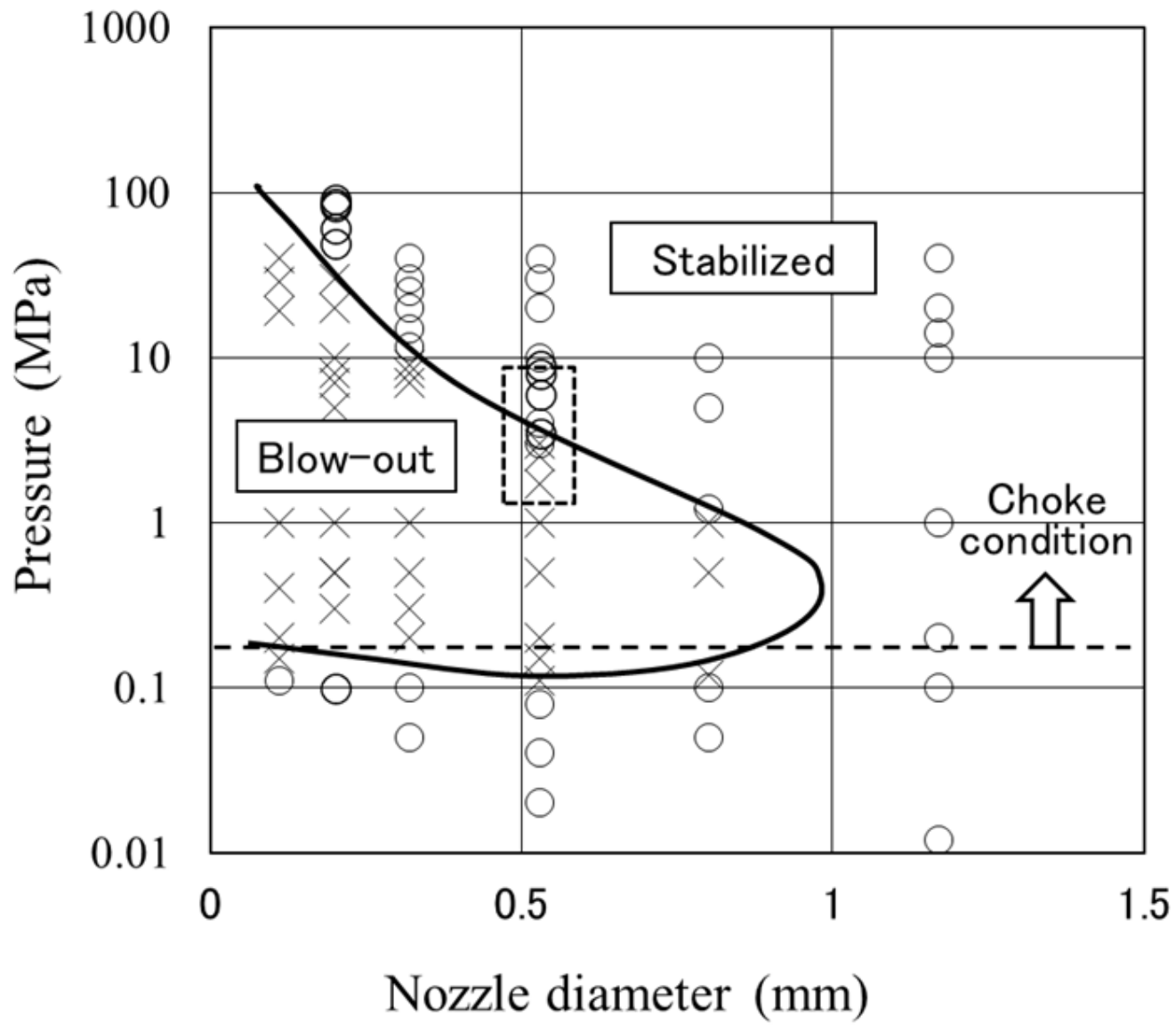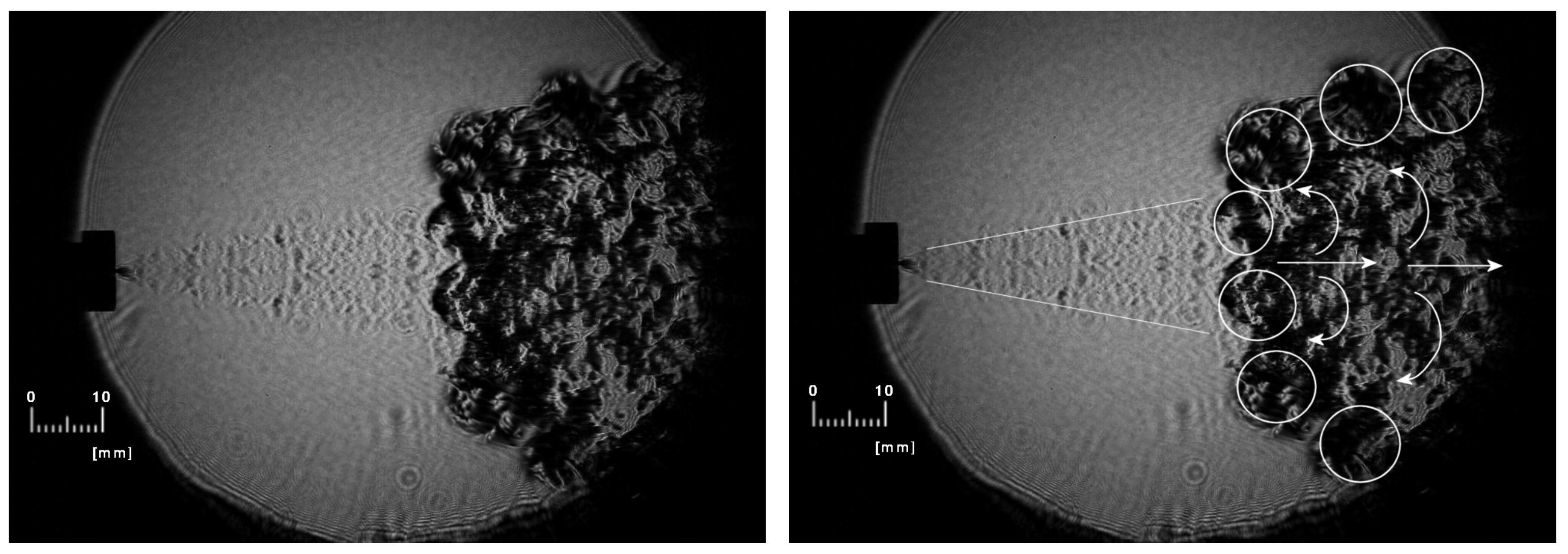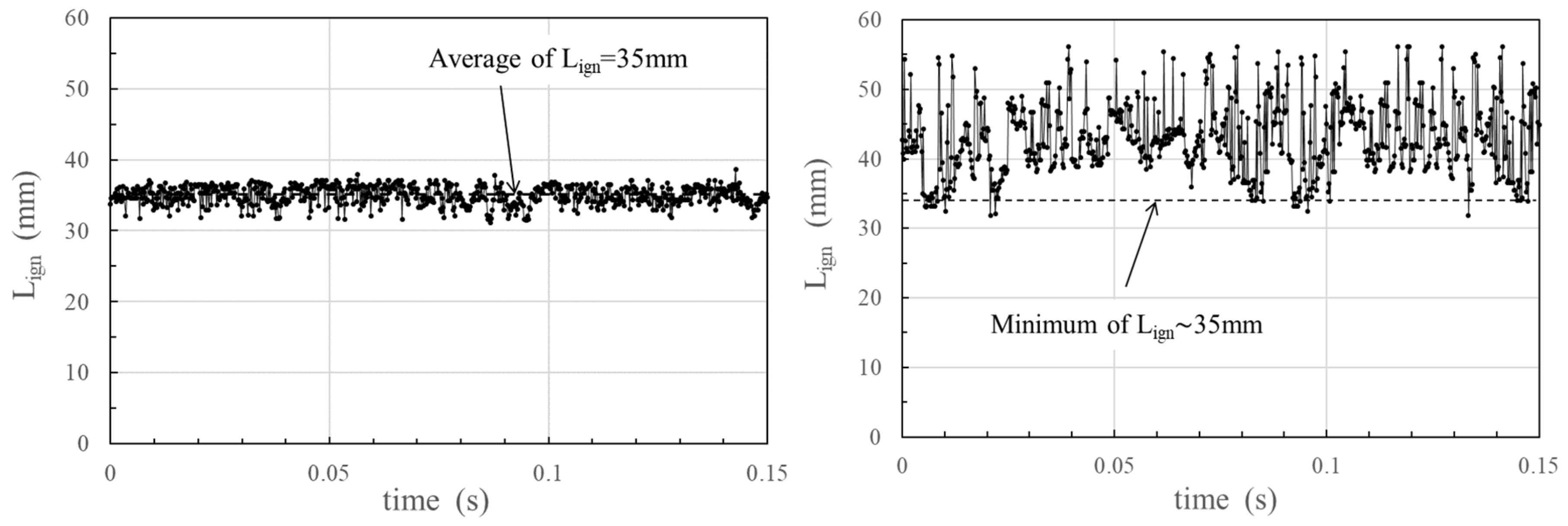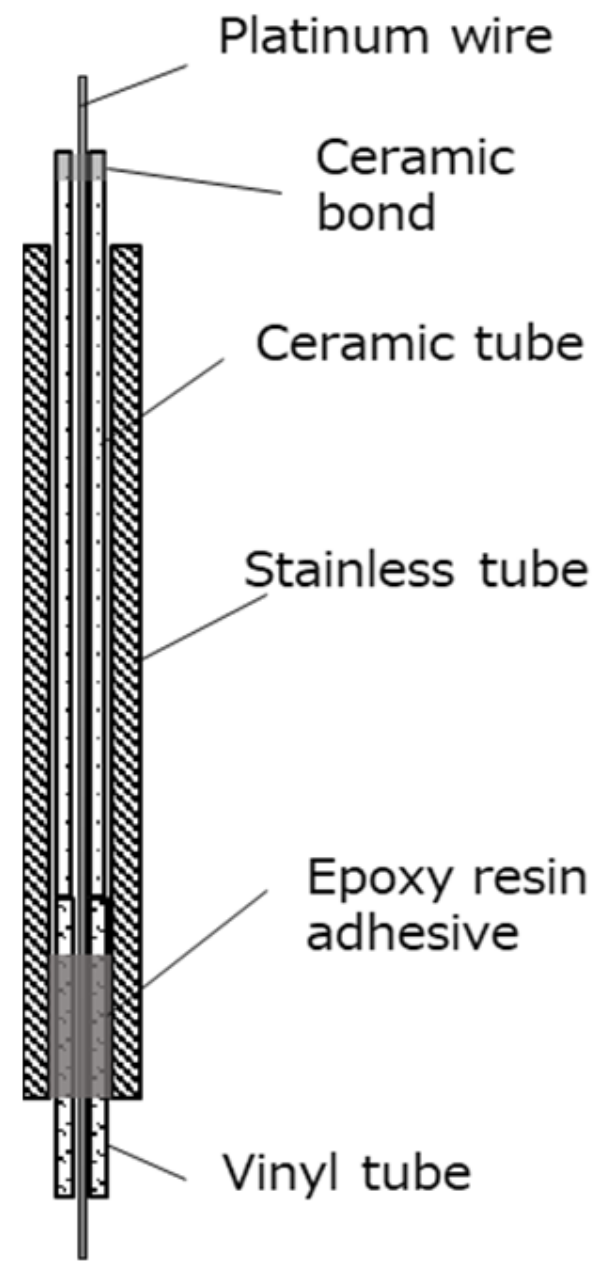Flame Stabilisation Mechanism for Under-Expanded Hydrogen Jets
Abstract
1. Introduction
2. Experiments and Discussion
2.1. Observations and Analysis of Flame Base Structures
2.2. Analysis of Flame Base Structure by PLIF Measurement
2.3. Measurement of Ion Current
3. Mechanisms of Flame Stabilisation
4. Conclusions
Author Contributions
Funding
Institutional Review Board Statement
Informed Consent Statement
Data Availability Statement
Acknowledgments
Conflicts of Interest
References
- Mazloomi, K.; Gomes, C. Hydrogen as an energy carrier: Prospects and challenges. Renew. Sustain. Energy Rev. 2012, 16, 3024–3033. [Google Scholar] [CrossRef]
- Fan, L.; Tu, Z.; Chan, S.H. Recent development of hydrogen and fuel cell technologies: A review. Energy Rep. 2021, 7, 8421–8446. [Google Scholar] [CrossRef]
- Wang, X.; Yi, F.; Su, Q.; Zhou, J.; Sun, Y.; Guo, W.; Shu, X. Influence of Longitudinal Wind on Hydrogen Leakage and Hydrogen Concentration Sensor Layout of Fuel Cell Vehicles. Sustainability 2023, 15, 10712. [Google Scholar] [CrossRef]
- Takeno, K.; Okabayashi, K.; Hashiguchi, K.; Noguchi, F.; Chitose, K. Experimental Study on open jet diffusion flame of 40MPa high-pressure hydrogen. Environ. Manag. 2005, 41, 33–40. [Google Scholar]
- Kessler, A.; Schreiber, A.; Wassmer, C.; Deimling, L.; Knapp, S.; Weiser, V.; Sachsenheimer, K.; Langer, G.; Eisenreich, N. Ignition of hydrogen jet fires from high pressure storage. Int. J. Hydrogen Energy 2014, 39, 20554–20559. [Google Scholar] [CrossRef]
- Xiaopeng, L. Flow characteristic of highly underexpanded jets from various nozzle geometries. Appl. Therm. Eng. 2017, 125, 240–253. [Google Scholar]
- Liang, Y.; Pan, X.; Zhang, C.; Xie, B.; Liu, S. The simulation and analysis of leakage and explosion at a renewable hydrogen refueling station. Int. J. Hydrogen Energy 2019, 44, 22608–22619. [Google Scholar] [CrossRef]
- Groethe, M.; Merilo, E.; Colton, J.; Chiba, S.; Sato, Y.; Iwabuchi, H. Large Scale Hydrogen Deflagrations and Detonations. In Proceedings of the International Conference on Hydrogen Safety, Pisa, Italy, 8–10 September 2005. [Google Scholar]
- Houf, W.G.; Evans, G.H.; Schefer, R.W. Analysis of jet flames and unignited jets from unintended releases of hydrogen. In Proceedings of the 2nd International Conference on Hydrogen Safety, San-Sebastian, Spain, 11–13 September 2007. Paper ID 1.1.65. [Google Scholar]
- Royle, M.; Willoughby, D.B. Consequences of Catastrophic Releases of Ignited and Unignited Hydrogen Jet Releases. Int. J. Hydrogen Energy 2010, 36, 2688–2692. [Google Scholar] [CrossRef]
- Grune, J.; Sempert, K.; Kuznetsov, M.; Jordan, T. Experimental Study of Ignited Unsteady Hydrogen Releases from a High Pressure Reservoir. Int. J. Hydrogen Energy 2013, 39, 6176–6183. [Google Scholar] [CrossRef]
- NEDO (New Energy and Industrial Technology Development Organization). Development of Technologies for Hydrogen Production, Delivery, and Storage Systems. Next Generation Technical Development, Feasibility Study Etc. Optimization of Regulations for FCV and Hydrogen Infrastructure, Project No. P08003, Final Report 20130000000912; II-10-A Technical Data for Hydrogen Stations Building. Available online: https://seika.nedo.go.jp/pmg/PMG01C/PMG01CG01?startId=1667364896449&forward=1 (accessed on 22 June 2023).
- Heon, H.S.; Daejun, C.; Soo, K.J. Experimental investigation of highly pressurized hydrogen release through a small hole. Int. J. Hydrogen Energy 2014, 39, 9552–9561. [Google Scholar] [CrossRef]
- Cirrone, D.; Makarov, D.; Friedrich, A.; Grune, J.; Takeno, K.; Molkov, V. Blast Wave Generated by Delayed Ignition of Under-Expanded Hydrogen Free Jet at Ambient and Cryogenic Temperatures. Hydrogen 2022, 3, 433–449. [Google Scholar] [CrossRef]
- Asahara, M.; Saburi, T.; Ando, T.; Takahashi, Y.; Miyasaka, T.; Kubota, S. Self-ignited flame behavior of high-pressure hydrogen release by rupture disk through a long tube. Int. J. Hydrogen Energy 2021, 46, 13484–13500. [Google Scholar] [CrossRef]
- Schefer, R.W.; Evans, G.H.; Zhang, J.; Ruggles, A.J.; Greif, R. Ignitability limits for combustion of unintended hydrogen release: Experimental and theoretical results. Int. J. Hydrogen Energy 2011, 36, 2426–2435. [Google Scholar] [CrossRef]
- Ruggles, A.J.; Ekoto, I.W. Ignitability and mixing of underexpanded hydrogen jets. Int. J. Hydrogen Energy 2012, 37, 17549–17560. [Google Scholar] [CrossRef]
- Takeno, K.; Okabayashi, K.; Kouchi, A.; Misaka, N.; Hashiguchi, K. Concentration Fluctuation and Ignition Characteristics during Atmospheric Diffusion of Hydrogen Spouted from high Pressure Storage. Int. J. Hydrogen Energy 2017, 42, 15426–15434. [Google Scholar] [CrossRef]
- Okabayashi, K.; Tagashira, K.; Kawazoe, K.; Takeno, K.; Asahara, M.; Hayashi, A.K.; Komori, M. Non-steady characteristics of dispersion and ignitability for high-pressurized hydrogen jet discharged from a pinhole. Int. J. Hydrogen Energy 2019, 44, 9071–9079. [Google Scholar] [CrossRef]
- Takeno, K. Characteristics and safety for open-jet flame of high-pressurized hydrogen. J. Combust. Soc. Jpn. 2010, 52, 121–129. [Google Scholar]
- Takeno, K.; Yamamoto, S.; Sakatsume, R.; Hirakawa, S.; Takeda, H.; Shentsov, V.; Makarov, D.; Molkov, V. Effect of Shock Structure on Stabilisation and Blow-off of Hydrogen Jet Flames. Int. J. Hydrogen Energy 2020, 45, 10145–10154. [Google Scholar] [CrossRef]
- Birch, A.D.; Brown, D.R.; Dodson, M.G.; Thomas, J.R. The Turbulent Concentration Field of a Methane Jet. J. Fluid Mech. 1978, 88, 431–449. [Google Scholar] [CrossRef]
- Annushkin, Y.M.; Sverdlov, E.D. Stability of Submerged Flames in Subsonic and Underexpanded Supersonic Gas-Fuel Streams. Combust. Explos. Shock Waves 1979, 14, 597–605. [Google Scholar] [CrossRef]
- Chung, S.H. Stabilization, Propagation and Instability of Tribrachial Triple Flames. Proc. Combust. Inst. 2007, 31, 877–892. [Google Scholar] [CrossRef]
- Wu, C.Y.; Chao, Y.C.; Cheng, T.S.; Li, Y.H.; Lee, K.Y.; Yuan, T. The Blowout Mechanism of Turbulent Jet Diffusion Flames. Combust. Flame 2006, 145, 481–494. [Google Scholar] [CrossRef]
- Molkov, V.; Makarov, D.; Bragin, M. Physics and modelling of under-expanded jets and hydrogen dispersion in atmosphere. In Physics of Extreme State of Matter; Russian Academy of Sciences: Moscow, Russia, 2009; pp. 143–145. [Google Scholar]
- Papanikolaou, E.; Baraldi, D.; Kuznetsov, M.; Venetsanos, A. Evaluation of notional nozzle approaches for CFD simulations of free-shear under-expanded hydrogen jets. Int. J. Hydrogen Energy 2012, 37, 18563–18574. [Google Scholar] [CrossRef]
- Li, X.; Christopher, D.M.; Hecht, E.S.; Ekoto, I.W. Comparison of two-layer model for hydrogen and helium jets with notional nozzle model predictions and experimental data for pressures up to 35 MPa. Int. J. Hydrogen Energy 2017, 42, 7457–7466. [Google Scholar] [CrossRef]
- Chizhikov, A.S. On the gas flow rate through a Mach disk in an underexpanded jet. J. Eng. Phys. Thermophys. 2009, 82, 315–320. [Google Scholar] [CrossRef]
- Buttay, R.; Lehnasch, G.; Mura, A. Turbulent mixing and molecular transport in highly under-expanded hydrogen jets. Int. J. Hydrogen Energy 2018, 43, 8488–8499. [Google Scholar] [CrossRef]
- Arnold, A.; Bomback, R.; Käppeli, B.; Schlegel, A. Quantitative measurements of OH concentration fields by two-dimensional laser-induced fluorescence. Appl. Phys. B 1997, 64, 579–583. [Google Scholar] [CrossRef]
- Müller, S.H.R.; Böhm, B.; Gleißner, M.; Arndt, S.; Dreizler, A. Analysis of the temporal flame kernel development in an optically accessible IC engine using high-speed OH-PLIF. Appl. Phys. B 2010, 100, 447–452. [Google Scholar] [CrossRef]
- Tang, X.; Dzieminska, E.; Asahara, M.; Hayashi, A.K.; Tsuboi, N. Numerical investigation of a high pressure hydrogen jet of 82 MPa with adaptive mesh refinement: Concentration and velocity distributions. Int. J. Hydrogen Energy 2018, 43, 9094–9109. [Google Scholar] [CrossRef]
- Shentsov, V.; Takeda, H.; Takeno, K.; Makarov, D.; Molkov, V. Influence of nozzle shape on hydrogen-air mixing for high pressure hydrogen jet. In Proceedings of the H2FC Supergen Researcher Conference, Nottingham, UK, 17–18 February 2020. [Google Scholar]
- Asahara, M.; Iwasa, T.; Tsuboi, N.; Hayashi, A.K. Numerical study on unsteady characteristics of high-pressure hydrogen jet ejected from a pinhole. Int. J. Hydrogen Energy 2022, 47, 31709–31728. [Google Scholar] [CrossRef]
- Takahashi, T.; Katsuki, M.; Mizutani, Y. Fine Flame Structure and Combustion Mechanism of Lean Turbulent Premixed Flames. JSME Int. J. Ser. B Fluids Therm. Eng. 1994, 37, 172–179. [Google Scholar] [CrossRef][Green Version]
- Shaikin, A.P.; Bobrovskij, I.N.; Deryachev, A.D.; Ivashin, P.V.; Galiev, I.R.; Tverdokhlebov, A.Y. Use of Ionization Sensors to Study Combustion Characteristics in Variable Volume Chamber. In Proceedings of the Global Smart Industry Conference, Chelyabinsk, Russia, 13–15 November 2018. [Google Scholar]
- Borghi, R. On the structure and morphology of turbulent premixed flames. In Recent Advances in Aerospace Science; Springer: New York, NY, USA, 1985; pp. 117–138. [Google Scholar]
- Peters, N. The turbulent burning velocity for large-scale and small-scale turbulence. J. Fluid Mech. 1999, 384, 107–132. [Google Scholar] [CrossRef]
- Miyauchi, T.; Tanahashi, M. Current State and Perspective of Turbulent Combustion Research. J. Fluid Sci. Technol. 2007, 2, 514–524. [Google Scholar] [CrossRef]
- Zhou, B.; Brackmann, C.; Wang, Z.; Li, Z.; Richter, M.; Aldén, M.; Bai, X.S. Thin reaction zone and distributed reaction zone regimes in turbulent premixed methane/air flames: Scalar distributions and correlations. Combust. Flame 2017, 175, 220–236. [Google Scholar] [CrossRef]
- Bradley, D.; Shehata, M.; Lawes, M.; Ahmed, P. Flame extinctions: Critical stretch rates and sizes. Combust. Flame 2020, 212, 459–468. [Google Scholar] [CrossRef]
- Mohammadnejad, S.; An, Q.; Vena, P.; Yun, S.; Kheirkhah, S. Thick reaction zones in non-flamelet turbulent premixed combustion. Combust. Flame 2020, 222, 285–304. [Google Scholar] [CrossRef]
- Kheirkhah, S.; Gülder, Ö.L. A revisit to the validity of flamelet assumptions in turbulent premixed combustion and implications for future research. Combust. Flame 2022, 239, 111635. [Google Scholar] [CrossRef]
- Nickels, T.B.; Marusic, I. On the different contributions of coherent structures to the spectra of a turbulent round jet and a turbulent boundary layer. J. Fluid Mech. 2001, 448, 367–385. [Google Scholar] [CrossRef][Green Version]









Disclaimer/Publisher’s Note: The statements, opinions and data contained in all publications are solely those of the individual author(s) and contributor(s) and not of MDPI and/or the editor(s). MDPI and/or the editor(s) disclaim responsibility for any injury to people or property resulting from any ideas, methods, instructions or products referred to in the content. |
© 2024 by the authors. Licensee MDPI, Basel, Switzerland. This article is an open access article distributed under the terms and conditions of the Creative Commons Attribution (CC BY) license (https://creativecommons.org/licenses/by/4.0/).
Share and Cite
Takeno, K.; Kido, H.; Takeda, H.; Yamamoto, S.; Shentsov, V.; Makarov, D.; Molkov, V. Flame Stabilisation Mechanism for Under-Expanded Hydrogen Jets. Fire 2024, 7, 48. https://doi.org/10.3390/fire7020048
Takeno K, Kido H, Takeda H, Yamamoto S, Shentsov V, Makarov D, Molkov V. Flame Stabilisation Mechanism for Under-Expanded Hydrogen Jets. Fire. 2024; 7(2):48. https://doi.org/10.3390/fire7020048
Chicago/Turabian StyleTakeno, Keiji, Hikaru Kido, Hiroki Takeda, Shohei Yamamoto, Volodymyr Shentsov, Dmitriy Makarov, and Vladimir Molkov. 2024. "Flame Stabilisation Mechanism for Under-Expanded Hydrogen Jets" Fire 7, no. 2: 48. https://doi.org/10.3390/fire7020048
APA StyleTakeno, K., Kido, H., Takeda, H., Yamamoto, S., Shentsov, V., Makarov, D., & Molkov, V. (2024). Flame Stabilisation Mechanism for Under-Expanded Hydrogen Jets. Fire, 7(2), 48. https://doi.org/10.3390/fire7020048







